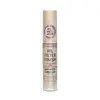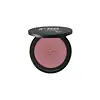What's inside
What's inside
 Key Ingredients
Key Ingredients

 Benefits
Benefits

 Concerns
Concerns

 Ingredients Side-by-side
Ingredients Side-by-side

Water
Skin ConditioningDimethicone
EmollientIsododecane
EmollientC13-15 Alkane
SolventPhenyl Trimethicone
Skin ConditioningSilica
AbrasiveButylene Glycol
HumectantIsobutylmethacrylate/Bis-Hydroxypropyl Dimethicone Acrylate Copolymer
Cetyl PEG/PPG-10/1 Dimethicone
EmulsifyingC30-45 Alkyl Dimethicone
Skin ConditioningQuaternium-90 Bentonite
Sorbitan Sesquioleate
EmulsifyingSodium Chloride
MaskingPhenoxyethanol
PreservativeDimethicone Crosspolymer
Emulsion StabilisingTriethyl Citrate
MaskingTocopheryl Acetate
AntioxidantEthylhexylglycerin
Skin ConditioningMethicone
EmollientHydrolyzed Hibiscus Esculentus Extract
Skin ConditioningDextrin
AbsorbentLecithin
EmollientPolyhydroxystearic Acid
EmulsifyingPentaerythrityl Tetra-Di-T-Butyl Hydroxyhydrocinnamate
AntioxidantEthylhexyl Palmitate
EmollientIsopropyl Myristate
EmollientIsostearic Acid
CleansingPolyglyceryl-3 Polyricinoleate
EmulsifyingSodium Hyaluronate
HumectantCI 77891
Cosmetic ColorantCI 77492
Cosmetic ColorantCI 77491
Cosmetic ColorantCI 77499
Cosmetic ColorantWater, Dimethicone, Isododecane, C13-15 Alkane, Phenyl Trimethicone, Silica, Butylene Glycol, Isobutylmethacrylate/Bis-Hydroxypropyl Dimethicone Acrylate Copolymer, Cetyl PEG/PPG-10/1 Dimethicone, C30-45 Alkyl Dimethicone, Quaternium-90 Bentonite, Sorbitan Sesquioleate, Sodium Chloride, Phenoxyethanol, Dimethicone Crosspolymer, Triethyl Citrate, Tocopheryl Acetate, Ethylhexylglycerin, Methicone, Hydrolyzed Hibiscus Esculentus Extract, Dextrin, Lecithin, Polyhydroxystearic Acid, Pentaerythrityl Tetra-Di-T-Butyl Hydroxyhydrocinnamate, Ethylhexyl Palmitate, Isopropyl Myristate, Isostearic Acid, Polyglyceryl-3 Polyricinoleate, Sodium Hyaluronate, CI 77891, CI 77492, CI 77491, CI 77499
Synthetic Fluorphlogopite
Silica
AbrasiveZinc Stearate
Cosmetic ColorantCaprylic/Capric Triglyceride
MaskingIsostearyl Neopentanoate
EmollientEthylhexyl Palmitate
EmollientCoco-Caprylate/Caprate
EmollientCaprylyl Glycol
EmollientEthylhexylglycerin
Skin ConditioningCI 77120
Cosmetic ColorantNiacinamide
SmoothingSodium Hyaluronate
HumectantSerica Powder
Skin ConditioningAscorbyl Palmitate
AntioxidantJojoba Esters
EmollientMagnesium Ascorbyl Phosphate
AntioxidantGlycerin
HumectantWater
Skin ConditioningButylene Glycol
HumectantHydrolyzed Collagen
EmollientTocopherol
AntioxidantCarbomer
Emulsion StabilisingSodium Lactate
BufferingPolysorbate 20
EmulsifyingPalmitoyl Tripeptide-1
Skin ConditioningPalmitoyl Tetrapeptide-7
Skin ConditioningMica
Cosmetic ColorantCI 77891
Cosmetic ColorantCI 77491
Cosmetic ColorantCI 77492
Cosmetic ColorantCI 77499
Cosmetic ColorantCI 77007
Cosmetic ColorantCI 45410
Cosmetic ColorantCI 15850
Cosmetic ColorantCI 19140
Cosmetic ColorantSynthetic Fluorphlogopite, Silica, Zinc Stearate, Caprylic/Capric Triglyceride, Isostearyl Neopentanoate, Ethylhexyl Palmitate, Coco-Caprylate/Caprate, Caprylyl Glycol, Ethylhexylglycerin, CI 77120, Niacinamide, Sodium Hyaluronate, Serica Powder, Ascorbyl Palmitate, Jojoba Esters, Magnesium Ascorbyl Phosphate, Glycerin, Water, Butylene Glycol, Hydrolyzed Collagen, Tocopherol, Carbomer, Sodium Lactate, Polysorbate 20, Palmitoyl Tripeptide-1, Palmitoyl Tetrapeptide-7, Mica, CI 77891, CI 77491, CI 77492, CI 77499, CI 77007, CI 45410, CI 15850, CI 19140
Ingredients Explained
These ingredients are found in both products.
Ingredients higher up in an ingredient list are typically present in a larger amount.
Butylene Glycol (or BG) is used within cosmetic products for a few different reasons:
Overall, Butylene Glycol is a safe and well-rounded ingredient that works well with other ingredients.
Though this ingredient works well with most skin types, some people with sensitive skin may experience a reaction such as allergic rashes, closed comedones, or itchiness.
Learn more about Butylene GlycolCi 77491 is also hydrated iron III oxide. It's sole purpose is to give a red/pink hue to products.
Iron III oxides are classified as inorganic chemicals for coloring.
Synthetically created Ci 77491 is considered safer than those naturally found. This is because the synthetically created version may contain less impurities. Iron oxides are generally non-toxic and non-allergenic.
Learn more about CI 77491Ci 77492 is also hydrated iron III oxide. It's sole purpose is to give a yellow hue to products.
Iron III oxides are classified as inorganic chemicals for coloring.
Synthetically created Ci 77492 is considered safer than those naturally found. This is because the synthetically created version may contain less impurities. Iron oxides are generally non-toxic and non-allergenic.
Learn more about CI 77492Ci 77499 is also hydrated iron III oxide. It is created from mixing red and black iron oxides. This helps give shades of darkness to a product.
Iron III oxides are classified as inorganic chemicals for coloring.
Ci 77891 is a white pigment from Titanium dioxide. It is naturally found in minerals such as rutile and ilmenite.
It's main function is to add a white color to cosmetics. It can also be mixed with other colors to create different shades.
Ci 77891 is commonly found in sunscreens due to its ability to block UV rays.
Learn more about CI 77891Ethylhexyl Palmitate, also known as octyl palmitate, is created from 2-ethylhexyl alcohol and palmitic acid. It is a fatty acid ester.
The fatty acid content of Ethylhexyl Palmitate makes it an emollient. Emollients help soften and hydrate your skin by trapping moisture within.
Ethylhexyl Palmitate is also used to help improve the texture of cosmetics. It helps other ingredient dissolve in products and help disperse ingredients more evenly.
You'll likely find this ingredient in sunscreen, as it is often used to mix UV-blocking ingredients such as avobenzone and ethylhexyl triazone.
It can also help stabilize the fragrances in a product as a fragrance fixative.
Ethylhexyl Palmitate can be used to substitute mineral oil.
Due to its high fatty acid content, it may not be fungal-acne safe.
Learn more about Ethylhexyl PalmitateEthylhexylglycerin (we can't pronounce this either) is commonly used as a preservative and skin softener. It is derived from glyceryl.
You might see Ethylhexylglycerin often paired with other preservatives such as phenoxyethanol. Ethylhexylglycerin has been found to increase the effectiveness of these other preservatives.
Silica, also known as silicon dioxide, is a naturally occurring mineral. It is used as a fine, spherical, and porous powder in cosmetics.
Though it has exfoliant properties, the function of silica varies depending on the product.
The unique structure of silica enhances the spreadability and adds smoothness, making it a great texture enhancer.
It is also used as an active carrier, emulsifier, and mattifier due to its ability to absorb excess oil.
In some products, tiny microneedles called spicules are made from silica or hydrolyzed sponge. When you rub them in, they lightly polish away dead skin layers and enhance the penetration of active ingredients.
Learn more about SilicaSodium Hyaluronate is hyaluronic acid's salt form. It is commonly derived from the sodium salt of hyaluronic acid.
Like hyaluronic acid, it is great at holding water and acts as a humectant. This makes it a great skin hydrating ingredient.
Sodium Hyaluronate is naturally occurring in our bodies and is mostly found in eye fluid and joints.
These are some other common types of Hyaluronic Acid:
Learn more about Sodium HyaluronateWater. It's the most common cosmetic ingredient of all. You'll usually see it at the top of ingredient lists, meaning that it makes up the largest part of the product.
So why is it so popular? Water most often acts as a solvent - this means that it helps dissolve other ingredients into the formulation.
You'll also recognize water as that liquid we all need to stay alive. If you see this, drink a glass of water. Stay hydrated!
Learn more about Water